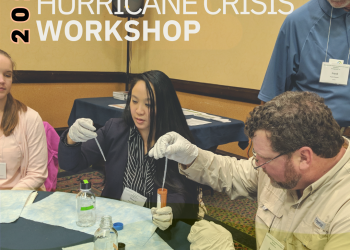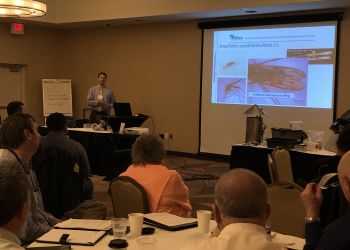 The U.S. Food & Drug Administration’s (FDA’s) Voluntary National Retail Food Regulatory Program Standards (Retail Program Standards) are designed to help food regulatory programs enhance the services they provide to the public.
The U.S. Food & Drug Administration’s (FDA’s) Voluntary National Retail Food Regulatory Program Standards (Retail Program Standards) are designed to help food regulatory programs enhance the services they provide to the public.
This post is part of NACCHO’s Retail Program Standards blog series, showcasing the progress that communities across the country have made in retail food protection. Each month, we are featuring the experiences, challenges, and successes of jurisdictions that have worked toward each standard.
All jurisdictions featured have participated in NACCHO’s Retail Program Standards Mentorship Program, which provides peer-to-peer assistance and intensive technical support to help jurisdictions conform with the standards efficiently and effectively.
This month we are focusing on Standard 6: Compliance and Enforcement and we are featuring Jersey County Health Department:
- Anna Yates, Senior Environmental Health Manager, Jersey County Health Department, Jerseyville, IL
What steps did you take to get started in your work on Standard 6?
Yates: When organizing the plan for Standard 6, I looked at several different documents that would help me get started. I started with the self-assessment of Standard 6 to see what I had already accomplished and what I still needed to accomplish. After reviewing the self-assessment and determining what I was missing, I pulled out our jurisdiction’s current compliance and enforcement policy. I documented and highlighted all the areas that were in compliance, which told me what I still needed to work on to meet the standard. I then created an Excel document for my inspection review, and I randomly picked the establishments under the Standard 6 criteria and started reviewing the files using the FDA food establishment worksheet provided. Next, I created an Excel spreadsheet to look at the statistics and see if I met the 80% compliance rate.
What was your biggest challenge in working toward Standard 6, and how have you worked to overcome that challenge?
Yates: Our biggest challenge in working toward Standard 6 was the inspection form. Illinois was currently using a different code than our jurisdiction. Illinois was in the process of adopting the 2013 FDA Food Code, which our jurisdiction had already adopted. As a result, some of the inspections that I was auditing were under the old code regulations and some fell under the new code regulations. I had to have two separate establishment file worksheets to compare and gather data.
What outcomes and benefits came out of working on Standard 6?
Yates: One benefit of working on Standard 6 was that we were able to audit our program to see if we were following the proper compliance and enforcement procedures. This definitely set the framework to see if our current policies were working and look at how we could improve for the future. We were quite happy with our outcome and success in reaching the 80% compliance that we were required to have. It has also helped us as we have continued improving our food program and training.
How do you sustain momentum in your work on Standard 6?
Yates: Momentum was hard to sustain as we were reviewing each of our establishment files. It can be such a tedious task. The best advice is to do a little at a time and set a schedule!
What tips do you have for other jurisdictions working toward Standard 6?
Yates:
- Use your resources! Reach out to other jurisdictions and ask to see their current policies and regulations.
- Get a mentor – Don’t be afraid to ask for help.
- Set a schedule and do a little at a time.
- Use FoodShield. It was nice to see the resources provided by other states to complete the same Standards.
Ed. Note: The FoodShield Mentorship Program Workgroup is a good resource to research forms and policies from multiple agencies; however, only mentorship program participants can access this workgroup. For others interested in viewing jurisdictions’ policies and forms, sign up for the FDA Retail Program Standards Workgroup on FoodSHIELD or view examples on NACCHO’s website.
How has your work on the Retail Program Standards overall affected your community in terms of public health outcomes?
Yates: Our work on the Retail Program Standards has greatly affected our relationship with the community. Since Illinois was in the process of adopting the FDA Food Code, our jurisdiction had the opportunity to build a framework to see how we could strengthen our knowledge and relationships by using the FDA Food Code. We achieved this in several ways. First, we trained our staff using the Standard’s requirements and developed a uniform system with the proper literature and inspection forms. This granted us the opportunity to make sure that all our staff were on the same page and that each establishment was under the same expectations. Then, once we went into the establishments, we focused on the five foodborne illness risk factors. This allowed us more time to educate the establishments about why these processes are important and how we could reduce the risk. We also have taken the time to develop new relationships with our community that we were otherwise lacking. We attend meetings hosted by our community leaders, teach classes about food safety, participate in interviews with local radio station, and share information on social media. Our greatest goal is to help prevent and control foodborne diseases any way we can to reach all consumers and industries in our jurisdiction.
Stay tuned for the next post, which will focus on Standard 7: Industry and Community Relations, coming in April.
Contact Amy Chang at [email protected] with any questions.






